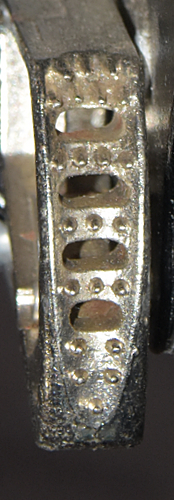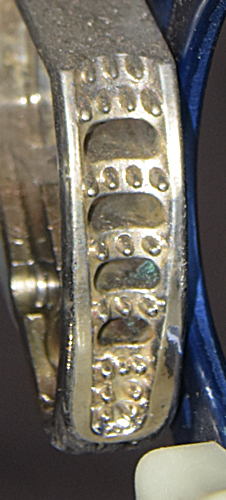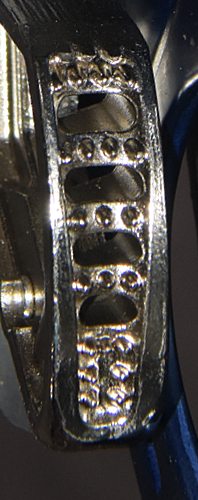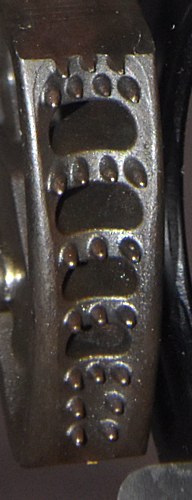Overview
History
Kong's history began in 1830 when Giuseppe Bonaiti opened the Bonaiti workshop on Lake Como in Lecco, Italy using with an engineering apparatus that was unusual for those times. That plant started producing Bonaiti carabiners in the early 1900s, establishing the Banaiti name in the climbing community. More climbing gear soon followed.
The Bonaiti company reorganized in 1977, adopted the name KONG, moved to the new factory of Monte Marenzo, and installed new machinery. In 1982 the company registered the name and trademark Kong in various countries. Kong continued to include the name Bonaiti on its products for many years.
The company is now managed by a sixth generation Bonaiti. Most Kong products are manufactured inside the Kong factory in Italy. Kong continues to produce carabiners and other tools used for safety in climbing, rescue, caving, yachting and work at height.
Considering their history, I see no reason to the separate the Kong-Bonaiti and Kong products by placing them on different
pages.
[ Top
| Kong-Bonaiti Lift
| Kong Lift, Version A
| Kong Lift, Version B
| Return to H.E.C. Ascenders
]
Kong-Bonaiti
(#223)
Technical details:
I acquired my Kong-Bonaiti on eBay from Brian Greco in 2007.
The Kong-Bonaiti came in both right and left-handed
versions. Each is 209 mm. high, 92 mm. wide, 29 mm.
thick, and weighs 232 g. The ascender shell is made from
two pieces of 3.5 mm. anodized aluminum sheet. The upper
piece forms the rope and cam channels, while the lower piece forms
the handle. Three semi-tubular rivets permanently connect the two pieces.
The upper piece is a subtriangular shape that is essentially
identical to the shell of the Kong-Bonaiti
Modular Ascender. The rope channel is formed by bending one
side of this piece into a U. The rope channel is 15.4 mm.
in diameter. The opposite side of the shell is bent on an inclined
axis to form another U. A hole drilled through both sides of the
U accepts a 5.5 mm.semi-tubular rivet. The cam and cam spring are
mounted on this rivet. The pivot is centered 42 mm. from
the inside of the rope groove. There is a stamped D-shaped cam
stop, but the cam contacts the inside of the rope groove before
reaching the stop.
There is an unbeveled 13 mm. hole located below the cam
near the rope channel, but this is blocked by the handle assembly,
so it cannot be used. An upper attachment point consists of two
unbeveled 17.3 mm. by 14.5 mm. holes through the rope
channel U, just above the cam. Another upper attachment point
lies above the cam pivot. This D-shaped hole is 12.2 mm.
wide and 10.4 mm. high. Three 5.5 mm. holes at the base
allow riveting the upper and lower shells together.
 The lower shell is made from 3.6 mm. anodized aluminum
alloy. There are no reinforcing ribs. The handle has a 102 mm
by 48 mm. oval hand opening. It has three holes at the top
that mate with the rivet holes in the upper shell. A 13.6 mm.
hole at the base forms the main sling attachment point. This hole
is not beveled. A black plastic hand grip is molded to the lower
shell. The handgrip has four shallow, closely spaced finger grooves.
The lower shell is made from 3.6 mm. anodized aluminum
alloy. There are no reinforcing ribs. The handle has a 102 mm
by 48 mm. oval hand opening. It has three holes at the top
that mate with the rivet holes in the upper shell. A 13.6 mm.
hole at the base forms the main sling attachment point. This hole
is not beveled. A black plastic hand grip is molded to the lower
shell. The handgrip has four shallow, closely spaced finger grooves.
The cam is a plated skeletonized aluminum casting. The cam
radius, measured from the pivot, increases from 38 mm. to
48 mm. over an angle of 42 °. The cam tooth pattern is
(3)(4.H)^2(3.H)^2(2.2.1) where H represents a mud relief hole.
A spring-loaded manual safety bar is mounted on the bottom of
the cam with a solid pin. The normal action of the spring holds
the safety against the cam. When the cam is opened, the shell
interferes with the safety bar, thus preventing opening the cam.
If the safety bar is moved away from the cam (opposing the spring),
it will clear the shell and the cam will open. At full open the
safety can be released and the spring will hold the safety against
the back of the shell. A pin riveted to the side of the safety
bar assists in operating the safety mechanism.
The front side of the right hand grip has "BONAITI - KONG
- ITALY" in raised letters, as does the rear side of the
left hand grip (making the two lower shell assemblies identical).
There are no markings on the upper shell assemblies or cams.
Imagine taking an innovative concept like modular ascender
and then defeating the whole purpose by permanently fastening
the parts together. Kong did this by riveting their Modular
Ascender and Caver Handle
together to create this ascender. I'll give Kong a Lemon Award  for this idea (although
not for the result, which works well). It doesn't take much thought
to realize that making the shell out of two pieces of aluminum
is unnecessary, inefficient, and unnecessarily expensive. Kong
realized the obvious and introduced Kong-Bonaiti Lift to replace this
one.
for this idea (although
not for the result, which works well). It doesn't take much thought
to realize that making the shell out of two pieces of aluminum
is unnecessary, inefficient, and unnecessarily expensive. Kong
realized the obvious and introduced Kong-Bonaiti Lift to replace this
one.
[ Top
| Kong-Bonaiti
| Kong Lift, Version A
| Kong Lift, Version B
| Return to H.E.C. Ascenders
]
Kong-Bonaiti Lift
(#139, 2199, 2202)
Technical Details
I acquired this pair of ascenders from Inner Mountain Outfitters
in August 1999. I acquired another pair and another left-handed ascender in 2017 as part of Bob Thrun’s collection.
The shell is a tall irregular shaped stamping made from 3.7 mm. aluminum alloy sheet metal. The stamping has a number of reinforcing
ribs. A rope channel is formed in the upper portion of one side
and a smaller cam channel lies opposite the first. A hole drilled
through both sides of the cam channel accepts a 5.5 mm. roll
rivet. The cam and cam spring are mounted on this rivet. The handle
below the cam has a soft plastic hand grip molded into place.
In typical Kong-Bonaiti fashion, the fluorescent handle glows
in the dark. The hand grip has four shallow finger grooves. A
13.5 mm. sling attachment hole is punched below the handle
opening, and a 9.8 mm. hole is punched beside it. A 14.4 by
17.6 mm. oval hole through both sides of the rope channel
provide an attachment point just above the cam. A 12.7 mm.
wide by 10.9 mm. high D-shaped hole is punched above the
cam pivot. There is a small (5 by 7 mm.) hole in the rope
channel opposite the cam contact point. A dimple serves as a cam
stop, but is nonfunctional because it is too high on the frame
to not touch the cam.
 The cam is a plated skeletonized steel casting. The cam has
number of small conical teeth, all of which have their axes approximately
parallel to the upper surface of the cam. The tooth pattern is
(3)(4.H)^2(3.H)^2(3.2.2) pattern, where "H" indicates
a hole. The inside surface of the cam is beveled, with the thick
side near the shell and the thin side on the outside. Like the
other ascenders, the inner cam face radius reduces from top to
bottom to accommodate various sized ropes. A spring-loaded manual
safety bar is mounted on the bottom of the cam with a small roll
rivet. The normal action of the spring holds the safety against
the cam. When the cam is opened, the shell interferes with the
safety bar, thus preventing opening the cam. If the safety bar
is moved away from the cam (opposing the spring), it will clear
the shell and the cam will open. At full open the safety can be
released and the spring will hold the safety against the back
of the shell. This provides a means of locking the cam open. A
knob on the safety bar assists in operating the safety mechanism.
The cam safety has a slight bend that makes it slightly easier
to operate.
The cam is a plated skeletonized steel casting. The cam has
number of small conical teeth, all of which have their axes approximately
parallel to the upper surface of the cam. The tooth pattern is
(3)(4.H)^2(3.H)^2(3.2.2) pattern, where "H" indicates
a hole. The inside surface of the cam is beveled, with the thick
side near the shell and the thin side on the outside. Like the
other ascenders, the inner cam face radius reduces from top to
bottom to accommodate various sized ropes. A spring-loaded manual
safety bar is mounted on the bottom of the cam with a small roll
rivet. The normal action of the spring holds the safety against
the cam. When the cam is opened, the shell interferes with the
safety bar, thus preventing opening the cam. If the safety bar
is moved away from the cam (opposing the spring), it will clear
the shell and the cam will open. At full open the safety can be
released and the spring will hold the safety against the back
of the shell. This provides a means of locking the cam open. A
knob on the safety bar assists in operating the safety mechanism.
The cam safety has a slight bend that makes it slightly easier
to operate.
The front of the ascender has a sketch of the ascender, an
arrow, and the word "LIFT" stenciled on the rope channel.
The rear has stencils saying "KONG," "Bonaiti,"
"Italy," the UIAA logo, "CE0426," "ø
8-13 mm.," and a date/serial number code ("9927052"
on the left, "99002872" on the right). A triangle and
exclamation point (which does not fit in the triangle) is stamped
on the inside of the shell, behind the cam. Left-hand Kong ascenders
are blue anodized, right-hand Kongs are red.
I feel that this is a well made ascender. All sharp edges have
been removed. The cam teeth are very well done. The attachment
points are simply holes in the shell, and although well rounded
I consider their small radius too sharp for directly attaching
sling ropes. They are probably acceptably rounded for webbing,
but considering the proximity of the attachment points to the
main rope, I would recommend using a small maillon for most attachments
in order to reduce the risk of sling abrasion. The lower attachment
hole could theoretically have the same safety problems as the
one on Clog Version A. The upper
rope attachment hole is located very close to the main rope. A
carabiner through the upper attachment hole may drag on the main
line. Note that such a carabiner will prevent putting the ascender
on or off rope, so one’s climbing system must be designed accordingly.
Single-handed operation of this ascender is fairly easy with
the proper hand, but is rather difficult with the opposite hand.
Closing an locked open ascender is much easier than opening, since
the strong cam spring assists the user. The cam is very well made.
The holes in the cam and the small hole in the shell are provided
as mud relief holes. For some types of mud they work well, on
others they don't - but nobody else’s handled eccentric cam ascender
can handle all mud conditions either. The holes on the Kong may
not help all of the time, but they don't hurt.
This ascender has the same pit lip disadvantage as the Clog. The shell is thinner that the one
on the Petzl Ascension or the VauDe
Anthron, but I like the location of the reinforcing better
on the Kong than the Petzl Ascension
(The VauDe Anthron isn't reinforced).
The Kong Lift is certainly worth considering if you are
looking for a stamped-frame handled ascender.
[ Top
| Kong-Bonaiti
| Kong-Bonaiti Lift
| Kong Lift, Version B
| Return to H.E.C. Ascenders
]
Kong Lift, Version A
(#2200)
Technical Details
 I acquired my Kong Lift, Version A in 2017 as part of Bob Thrun’s collection.
I acquired my Kong Lift, Version A in 2017 as part of Bob Thrun’s collection.
The Kong Lift, Version A is 200 mm. tall, 97 mm. wide, 26 mm. thick, and weighs 216 g
The Kong Lift replaced the Kong-Bonaiti Lift’s phosphorescent handle with a black rubberized plastic handle.
The front of the ascender has a sketch of the ascender on an anchored rope, a dashed
up-pointing arrow, "LIFT," either "SX" (left) or "DX" (right), and "ø8÷13 mm." printed on the rope channel.
The rear has the KONG ITALYlogo, the UIAA logo, "CE0426, and either "04082 04" (left) or "02627 04" (right). A triangle and
exclamation point (which does not fit in the triangle) is stamped
on the inside of the shell, behind the cam. Left-handed Kong ascenders
are blue anodized, right-handed Kongs are red.
The change in the handle material is an improvement. My experience with the Phosphorescent handles is that they degrade with time, become brittle, and break, leaving only the underlying aluminum stamping.
[ Top
| Kong-Bonaiti
| Kong-Bonaiti Lift
| Kong Lift, Version A
| Return to H.E.C. Ascenders
]
Kong- Lift, Version B
(#2016, 2017)
Technical Details
 I acquired my left-hand Kong Lift, Version B from unbeatablesale.com and my right-hand from SiteLead, Inc., both on eBay in 2015.
I acquired my left-hand Kong Lift, Version B from unbeatablesale.com and my right-hand from SiteLead, Inc., both on eBay in 2015.
The Kong Lift is 199 mm. tall, 96 mm. wide, 25 mm. thick, and weighs 229 g.
Version B uses a bent tab instead of a pin on the cam safety.
The front of the ascender has a sketch of the ascender on an anchored rope, a dashed
up-pointing arrow, "LIFT," and either "SX" (left) or "DX" (right) printed on the rope channel.
The rear has the UIAA logo, "CE0426," a book-with-an-"i" icon, EN 567:13, a rope icon, "Ø8÷13 mm," EN 12841:06/B 100kg," another rope icon, "•Ø8÷13 mm," "MEETS NFPA 1983(2012ED)T," "MBS 5 kN," yet another rope icon, "•Ø8÷13 mm," "Made in Italy," "143637 14 0123.," and the Kong Italy logo. A triangle and
exclamation point (which does not fit in the triangle) is stamped
on the inside of the shell, behind the cam. Left-handed Kong ascenders
are black anodized, right-handed Kongs are red.
|
 |
Warning:
The weight ("100kg") printed on the handle can easily be
less than the weight of a fully loaded caver. |
 |
|
I find that the change to the cam safety less than desirable. The tab does not provide as secure a grip as the pin did, and my thumb tends to slip.
The weight ("100kg") printed on the rear of each ascender can easily be less than the weight of a fully loaded caver. Although I know what this means, American courts may not, so I cannot recommend this ascender for heavier cavers or for expedition caving.
[ Top
| Kong-Bonaiti
| Kong-Bonaiti Lift
| Kong Lift, Version A
| Kong Lift, Version B
]


